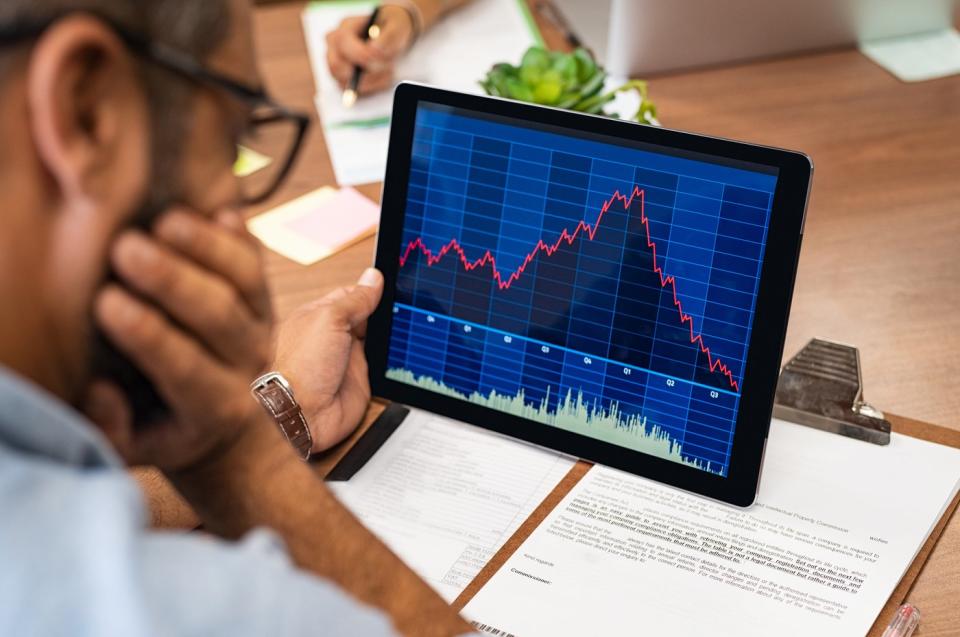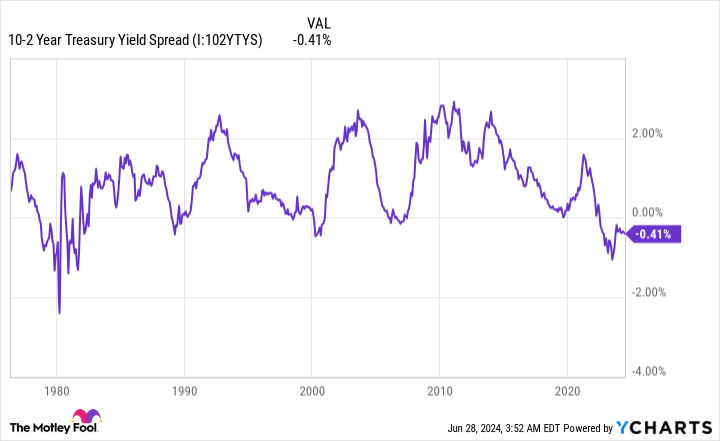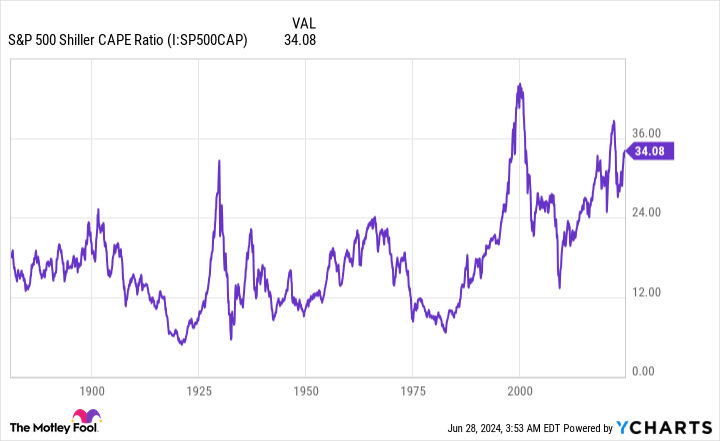Over the long term, Wall Street has proven to be a true wealth creator. While other asset classes, such as bonds and housing, have made investors richer, nothing else comes close to the average annual return that stocks have delivered for more than a century.
Wall Street is currently enjoying another roaring bull market. Since the green flag flew in early 2023, it has been timeless Dow Jones Industrial Average (DJINDICES: ^DJI)benchmark S&P500 (SNPINDEX: ^GSPC)and growth driven Nasdaq Composite (NASDAQINDEX: ^IXIC) are up 18%, 43% and 71% respectively as of the closing bell on June 27, 2024.

But if one thing is clear on Wall Street, it’s that stocks don’t rise in a straight line. As artificial intelligence (AI) and stock split euphoria fuel the current bull market, three predictive indicators with historically strong correlations to Wall Street’s downtrend appear to predict a potential stock market crash in 2024.
A historic decline in the US M2 money supply
To be clear, no single metric can predict short-term directional movement for the major stock indices with guaranteed accuracy. However, certain indicators have historically shown a knack for predicting declines in the Dow Jones, S&P 500, and Nasdaq Composite. U.S. M2 money supply is one such metric.
The M2 money supply includes everything you would find in M1 — cash and coins in circulation, as well as deposits in checking accounts — and adds money market accounts, savings accounts and certificates of deposit (CDs) under $100,000. Think of M1 as money that can be spent on the spot and M2 as money that can still be spent fairly easily, but requires more work to get to.
For nine decades, the M2 money supply has expanded almost continuously. In other words, more capital in circulation is needed to support a growing economy.
WARNING: The money supply is officially shrinking. 📉
This has only happened four times in the past 150 years.
Each time, a depression followed with double-digit unemployment rates. 😬 photo.twitter.com/j3FE532oac
— Nick Gerli (@nickgerli1) March 8, 2023
But since its peak in April 2022, M2 has fallen significantly. While the US money supply has increased by 0.69% year-over-year, on an aggregate basis US M2 money supply has fallen by 3.49% since its all-time high. As you can see in the post on X by Nick Gerli, CEO of Reventure Consulting, this is only the fifth time since 1870 (when back-testing) that M2 has fallen by at least 2% on an annualized basis (1878, 1893, 1921, 1931-1933, and 2023).
The previous four instances of M2 falling by at least 2% correlated with periods of double-digit unemployment and economic depressions. While two of these occurred before the Federal Reserve was created, and the likelihood of a depression today is very low, the bottom line is that less capital in circulation leads to less discretionary purchasing by consumers. In short, it’s a recipe for recession — and the stock market historically underperforms once a recession is declared.
The longest yield curve inversion in modern times
The second predictive tool that seems to predict trouble for Wall Street is the Treasury yield curve. Compared to the M2 money supply, this is a much more popular metric.
Normally, the Treasury yield curve slopes up and to the right. This means that Treasury bonds with a longer term (maturity in 10 or 30 years) have higher yields than Treasury bills that mature in one year or less. The longer your money is tied up in an interest-bearing asset, the higher the return should be.


Since July 5, 2022, the spread (difference in yield) between the 10-year bond and the two-year Treasury bill has been underwater. In other words, two-year government bonds have yielded higher than ten-year government bonds. This is known as a yield curve inversion, and it is the longest in modern times.
Here’s the interesting thing about yield curve inversions: They have preceded every U.S. recession since the end of World War II. About two-thirds of the peak-to-trough declines in the S&P 500 have occurred during U.S. recessions.
However, and this is one big “However,” not every yield curve inversion is followed by a recession. Consider a yield curve inversion a necessary ingredient that signals that the U.S. economy is facing headwinds.
Stocks are exceptionally expensive
The third predictive measure that suggests a potential stock market crash could be coming is the valuation-based Shiller price-to-earnings (P/E) ratio, also called the cyclically adjusted price-to-earnings ratio (CAPE).
While traditional price-to-earnings ratios focus on earnings over the past 12 months, the Shiller P/E ratio for the S&P 500 is based on average inflation-adjusted earnings over the past 10 years. Examining a 10-year history of earnings smooths out the “hiccups” (such as the effects of COVID-19) that could otherwise distort investors’ perceptions of value.


At the closing bell on June 27, the S&P 500’s Shiller P/E was 35.70. For comparison, this is more than double the average of 17.13 in backtesting over the past 153 years.
What’s important about the Shiller P/E is examining how Wall Street’s major stock indexes reacted when they crossed 30 during a bull market. Since 1871, this has happened six times: 1) August 1929 – September 1929, 2) June 1997 – August 2001, 3) September 2017 – November 2018, 4) December 2019 – February 2020, 5) August 2020 – May 2022, and 6 ) November 2023-current.
The five previous times the Shiller price/earnings ratio exceeded 30 ultimately resulted in the Dow Jones Industrial Average, S&P 500 and/or Nasdaq Composite losing between 20% and 89% of their value.
As you can see from the data in these six cases, there is no rhyme or reason to how long stocks can stay expensive. What is clear is that extended valuations are not sustainable over the long term. Historically, when the S&P 500’s Shiller P/E ratio is above 30 for an extended period of time, it has been a cautionary tale of a bear market and/or potential crash.


Time and perspective change everything
Again, the three predictive numbers above suggest that the ingredients are in place for a possible stock market crash in 2024. What they don’t do is guarantee anything. It is impossible to predict specifically what stocks will do in a week, a month or even a year.
But when investors take a step back and broaden their perspectives, it becomes a lot easier to predict where stocks are collectively headed.
Take the economic cycle as a good example. As much as workers may detest the idea of slowdowns and recessions, the fact remains that they are perfectly normal. No amount of good wishes can prevent recessions from occurring.
However, this boom-bust cycle for the economy is not linear. Since the end of World War II in September 1945, nine of the twelve U.S. recessions were resolved in less than a year, and none of the remaining three lasted longer than eighteen months. By comparison, most periods of economic growth lasted for several years, with two expansions lasting longer than a decade. Being an optimist and confident that the US economy will grow has undoubtedly been a smart move.
The same dynamics are playing out on Wall Street.
In June 2023, Bespoke Investment Group made the post you see above on the average length of bull markets (1,011 calendar days) for the S&P 500 is approximately 3.5 times longer than the typical S&P 500 bear market (286 calendar days).
Moreover, nearly half of the S&P 500 bull markets (13 of 27) outlasted the longest bear market in a 94-year period.
A comprehensive data set from Crestmont Research’s investment advisors adds to the value of time and perspective. Crestmont analysts calculated the 20-year rolling total return of the S&P 500, including dividends, backtested to 1900. This study yielded 105 rolling 20-year periods (1919-2023).
What this data set showed was that all 105 rolling 20-year periods would have produced positive annualized total returns. In plain English, if you had hypothetically bought an S&P 500 tracking index at any point since 1900 and held that position for 20 years, you would have made money every single time, without exception.
No matter how scary the data or short-term forecasts seem, time and perspective have not failed investors.
Don’t miss this second chance at a potentially lucrative opportunity
Have you ever felt like you missed the boat on buying the most successful stocks? Then you want to hear this.
On rare occasions, our expert team of analysts provides a “Double Down” Stocks recommendations for companies they think are about to explode. If you’re worried that you’ve already missed your chance to invest, now is the best time to buy before it’s too late. And the numbers speak for themselves:
-
Amazon: If you had invested $1,000 when we doubled in 2010, you would have $21,765!*
-
Apple: if you invested $1,000 when we doubled in 2008, you would have $39,798!*
-
Netflix: if you invested $1,000 when we doubled in 2004, you would have $363,957!*
We’re currently issuing “Double Down” alerts for three incredible companies, and there may not be another opportunity like this soon.
See 3 “Double Down” Stocks »
*Stock Advisor returns as of June 24, 2024
Sean Williams has no position in any of the stocks mentioned. The Motley Fool has no position in any of the stocks mentioned. The Motley Fool has a disclosure policy.
Stock market crash 2024? 3 Predictive Stats That Indicate a Significant Stock Drop is Coming was originally published by The Motley Fool







